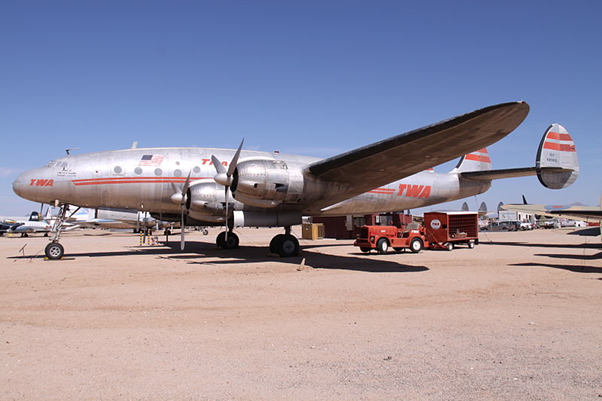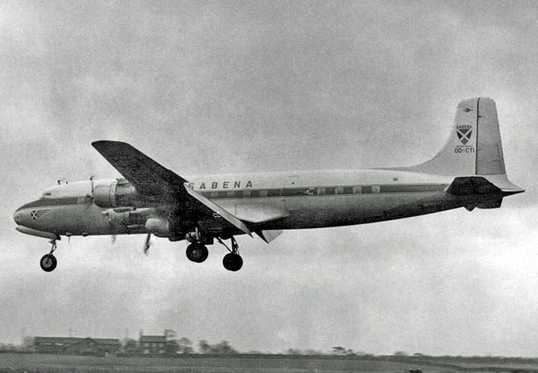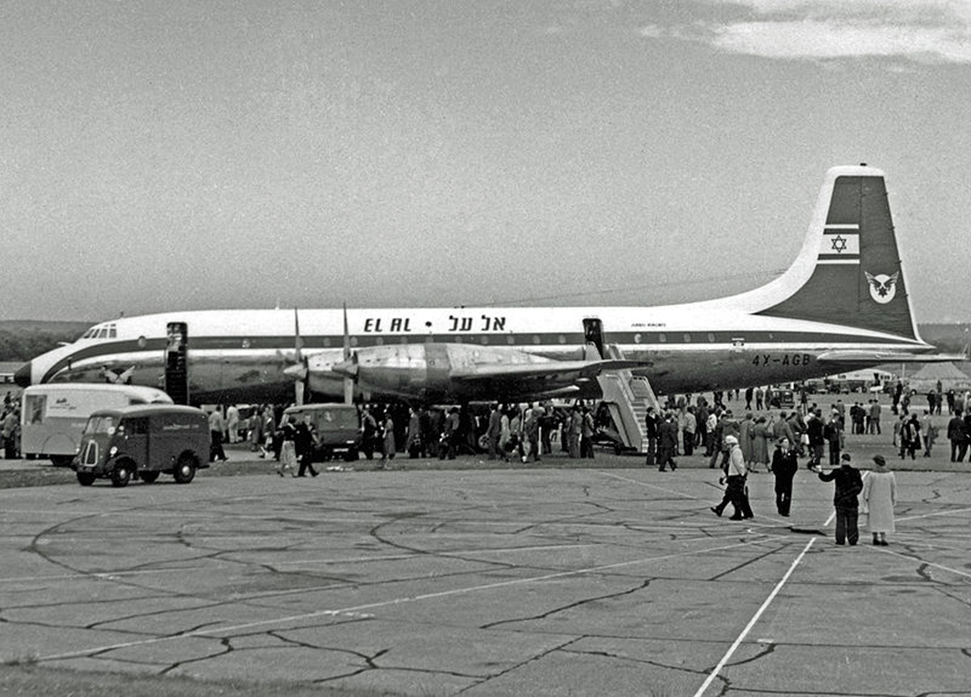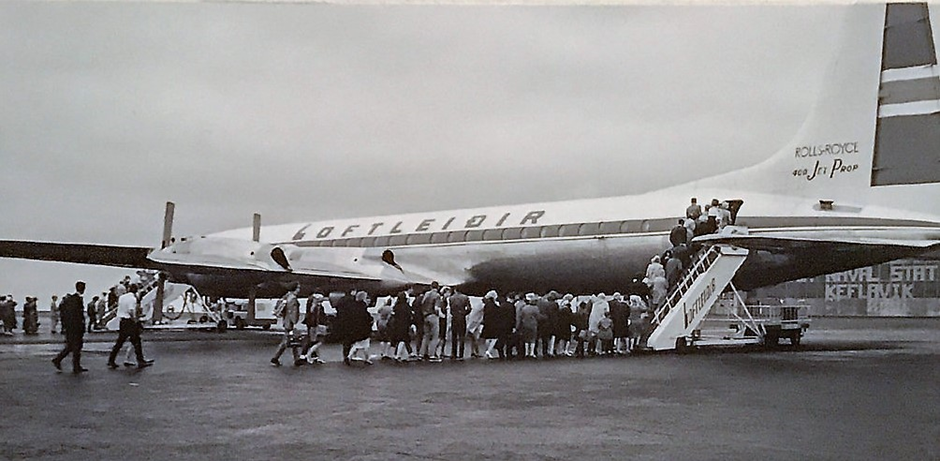


Before the Second World War if you wanted to fly on a scheduled flight across the Pacific or Atlantic Oceans it would have been on a flying boat, after the war all that changed. With the availability of many new airfields with hard runways designed for long range bombers the way was now clear for land planes to replace the existing flying boat services. With all of Europe having spent the past six years designing nothing but fighters and bombers it was the Americans who provided the transport aeroplanes to make this transition possible. In the latter years of the conflict Douglas and Lockheed had provided the USAAF with new transport aircraft, the DC-4 and Constellation. The DC-4 had first flown in 1942 and the Constellation in 1943. It was to be these two types that heralded in the demise of the flying boat over the Oceans.

Following the end of the war the American authorities gave transatlantic traffic rights to Pan American Airlines, TWA and American Overseas Airlines (AOA). In October 1945 a DC-4 of AOA left New York staging via Boston, Gander and Shannon before arriving at London Airport to lay claim to being the first landplane to have operated a scheduled service across the Atlantic. AOA went from strength to strength ordering Lockheed Constellations in 1946 and Boeing Stratocruisers in 1949.The AOA name was to disappear in 1950 when Pan American took over its smaller rival.
The UK had high hopes of joining the party with its Bristol Brabazon which was being developed for the atlantic crossing. But as history would show when the Brabazon first took to the sky in 1949 it was already out of date and the sole example was grounded in 1953, leaving the way clear for the Americans to dominate the long haul airliner market for many years to come.

With the three US airlines all operating modern equipment here in the UK BOAC was looking somewhat overshadowed with its collection of flying boats and modified Liberator bombers. To even up the playing field, in 1946 the corporation approached the UK government for permission to spend US dollars on a fleet of Lockheed Constellations. With no suitable British aircraft available the government reluctantly agreed and BOAC began its long association with the American commercial aircraft industry when it began operating five of the Lockheed airliners. It did however still continue to operate flying boats mainly on the Empire routes up until 1950. The Constellation was a popular choice on the US-UK route with AOA, TWA, Pan Am and BOAC all at one time or another using them as their primary equipment on the route. There would be 856 Constellations built. TWA’s first transatlantic route had been New York to Paris using a Constellation in February 1946, just a year after it had placed the big Lockheed into service. This flight along with most others at the time staged via Gander in Canada and Shannon in Ireland for refuelling. These two airports were very busy places in the late 1940s-mid 1960s.

Before it took delivery of the Constellation, Pan American had been flying from New York to Bournemouth (Hurn) using its DC-4 fleet. These flights started in January 1946 and took a total time including refuelling stops of nearly 18 hours. Bear in mind the DC-4 was unpressurized so had to fly around 10,000 feet, well in the face of any weather fronts it might meet across the North Atlantic. The cheaper and more available DC-4 made it the plane of choice for many European airlines. Only 80 pure airliner DC-4s were built but there were large numbers of ex-military versions, the C-54, available on the market. Consequently the type was purchased not only by the larger airlines but also by many smaller charter companies who also plied the Atlantic route. Air France, Sabena, SAS, KLM and Swissair were just a few of the DC-4 operators. Air France offered a Paris to New York service via as usual Shannon and Gander which took a whopping 20 hours to complete. This service commenced in July 1946 but by the following year the faithful old Douglas had been replaced by Constellations.

One airline that went its own way to a certain degree was Trans Canada Airlines. They used from 1947 the Canadair North Star on its Canada -Europe routes right up until 1954 when they were replaced by Lockheed Super Constellations. The North Star was basically a Merlin-powered DC-4 which gave it an almost 100mph higher top speed than the Pratt and Whitney radial engine version. Plus, a huge advantage over the DC-4, the North Star was pressurised. 71 would be built. BOAC would also fly the North Star but would call their fleet Argonauts and used them to replace the Hermes.

Douglas had not rested on its laurels after the success of the DC-4 and it realised the lack of pressurisation was a problem, so in early 1946 it flew a larger, pressurised aeroplane named the DC-6. The ‘6’ would be the natural replacement for the DC-4 and many airlines made the swap to the larger much more capable aeroplane bringing total production up to 704 aircraft. Douglas didn’t have things all its own way as Boeing were interested in a slice of the large airliner pie and a year after the DC-6 first flew the Seattle company launched is B-29 Bomber derivative the Boeing 377 Stratocruiser. The Strat saw service with amongst others Pan American, BOAC, AOA, Trans Ocean and even the Israeli Air Force. Trans Ocean would use their for flights out of Oakland California across the Pacific to Hawaii and beyond to Asia. 1949 was the Stratocruiser’s big year when AOA, Pan American and BOAC all put their aircraft into service. Always somewhat unreliable and expensive to operate Boeing would only build 56 examples before concentrating on the development of its first jet airliner the 707.

With quite low sales of the Stratocruiser it was left to Douglas and Lockheed to provide most of the long haul airliners. As we have seen, Douglas came up with the larger and improved DC-6 in 1946, but despite several small upgrades to the original Constellation it was not until 1951 that Lockheed first flew the larger Super Constellation which would see sales amounting to 259 aeroplanes. SAS airlines had replaced their earlier DC-4s with the newer DC-6 and it was one of these aircraft that operated the first trans-polar route when in 1954 it flew Copenhagen to Los Angeles over the North pole with refuelling stops in Greenland and Winnipeg. When SAS later took delivery of the long range DC-7C it again flew over the polar route from Copenhagen to Tokyo via Anchorage. Another European operator of the DC-6 was Sabena who used the new aeroplane to replace its DC-4s on the Brussels- New York route and also in 1953 using the DC-6, was the first airline to offer a service on the route Manchester to New York.

With the DC-6 and Super Constellations well established on the transatlantic route the manufacturers had a look at what they could do to cut out the refuelling stops which these aircraft still needed and of course added several hours to the overall flight time. Douglas had already planned a larger version of the DC-6 to compete with the Super Connie, following on with its series the new aeroplane would be known as the DC-7 and would be powered by the very complex but powerful Wright R-3350 Turbo-Compound engine giving a 20 per cent increase in power over the older P&W R2800 powered DC-6. A long range version the DC-7C would be the ultimate and last Douglas piston powered airliner for long haul flights. Having first flown in May 1953 the DC-7 first entered service in the guise of the DC-7B with American Airlines. When more powerful engines became available Douglas lengthened the wing by 10 feet which allowed an extra 1000 US gallons of fuel to be carried also lengthening the fuselage to make the DC-7C a long haul airliner that could now fly either way across the Atlantic non- stop. Marketed as the DC-7C, Seven Seas the new aeroplane first entered service in May 1955 with Pan Am. 338 DC-7s would be produced 121 of them the DC-7C version and it became the last piston engine long haul airliner for many of the world’s airlines.

Having flown almost three years before the Seven Seas it was the Turbo-prop Bristol Britannia with which BOAC had hoped to replace its fleet of piston powered Constellations and Stratocruisers. However long delays in the development of that aircraft left the state-owned airline between two stools and its only option to keep up with the world’s airlines was in 1956 to again go cap-in-hand to the government for permission to purchase a number of DC-7Cs pending delivery of the Britannia. So new piston powered aircraft were added to the BOAC fleet, the last thing the airline really wanted as it had hoped to leapfrog all the competition with the introduction of the Britannia. With the big Douglas now the king of the Atlantic, Lockheed gave itself one more throw of the dice and like Douglas with the DC-7 made major changes including a whole new wing design to their Super Constellation and came up with the Lockheed L1649 Starliner. First flying in October 1956 just 44 of these aircraft, the ultimate piston engine airliner, would be built. The Starliner although slower than the DC-7C had even more range so en route refuelling stops became a thing of the past and the heydays at Gander and Shannon began to become faded memories.

With only 44 airframes built the Starliner really was the last throw of the dice for piston long-haul airliners. Operated from 1957 mainly by Air France, Lufthansa and TWA they were soon past on to other airlines as the jets arrived just a couple of years later. In 1957 TWA flew the first Los Angeles-London non- stop flight using a Starliner. Just four of these magnificent aeroplanes survive. One is in South Africa in the colours of Trek Airways, one at a museum in Florida, one now being used as a cocktail bar at the JFK hotel painted in TWA colours and finally one which has had millions of euros spent on it by Lufthansa in an aborted project to return it to flight. It now lies dismantled in a storage facility in Germany.

So what of BOAC and their hoped for world-beating Britannia? BOAC eventually received the first of its Britannias in 1955, but these were not the long-haul 300 series. They didn’t arrive until 1957 and it was on 19 December 1957 that the first BOAC Britannia crossed the Atlantic to Canada and later that month saw the beginning of services to New York. Other airlines that saw the potential of the Britannia across the Atlantic were El Al and Canadian Pacific Airlines who also started operations across the pond. Another Britannia operator who flew the Atlantic from time to time was Cubana who operated a service from Havana to Prague. But the long delay in bringing the Britannia into service had been its downfall as the early jets were just months away and the airlines still operating piston engine aircraft waited to make the quantum leap to the pure jet, hence only 85 Britannias would be built, many for the RAF.

The last propeller-driven aircraft to join the transatlantic fleets was the Canadair CL-44s of Icelandic airline Loftleidir. The CL-44 was a larger derivative of the Britannia built in Canada by Canadair and powered by Rolls Royce Tyne engines. Loftleidir was the only airline to operate the type as a passenger aircraft and its Cl-44J could carry 189 passengers making it the largest airliner across the Atlantic at the time. First flown in 1964 flights would operate from Luxemburg to the US via Reykjavik. Going via their home base meant a lower cost base for the airline and Loftleidir offered the cheapest, if not the quickest, route to Europe for the Americans. Many students used the airline to visit Europe and the service became known as the ‘Hippie Flights ‘

In October 1958 the writing was on the wall as two de Havilland Comet 4 aircraft of BOAC crossed the Atlantic one in each direction heralding a new dawn of fast comfortable air travel across the water. The Boeing 707 would join them in a matter of weeks and those heady days of props across the water would soon be gone with all the major airlines falling over themselves to buy jets. The smaller and charter airlines continued to fly the old Douglas’, Lockheeds and Britannias back and forth for many more years but the glamorous heyday of the propeller powered long haul airliner had gone. We will finish with one final look back at one of the most glamorous - the Lockheed Super Constellation.

‘till the next time Keith
Additional Note: Aeroflot also operated the Tupolev Tu-114 turboprop across the Atlantic with flights starting in 1962 from Moscow to Havana, later services would also start to Montreal . The Tu-114 was the fastest propeller driven airliner built and could reach speeds of 550mph.
Registered Charity No. 285809